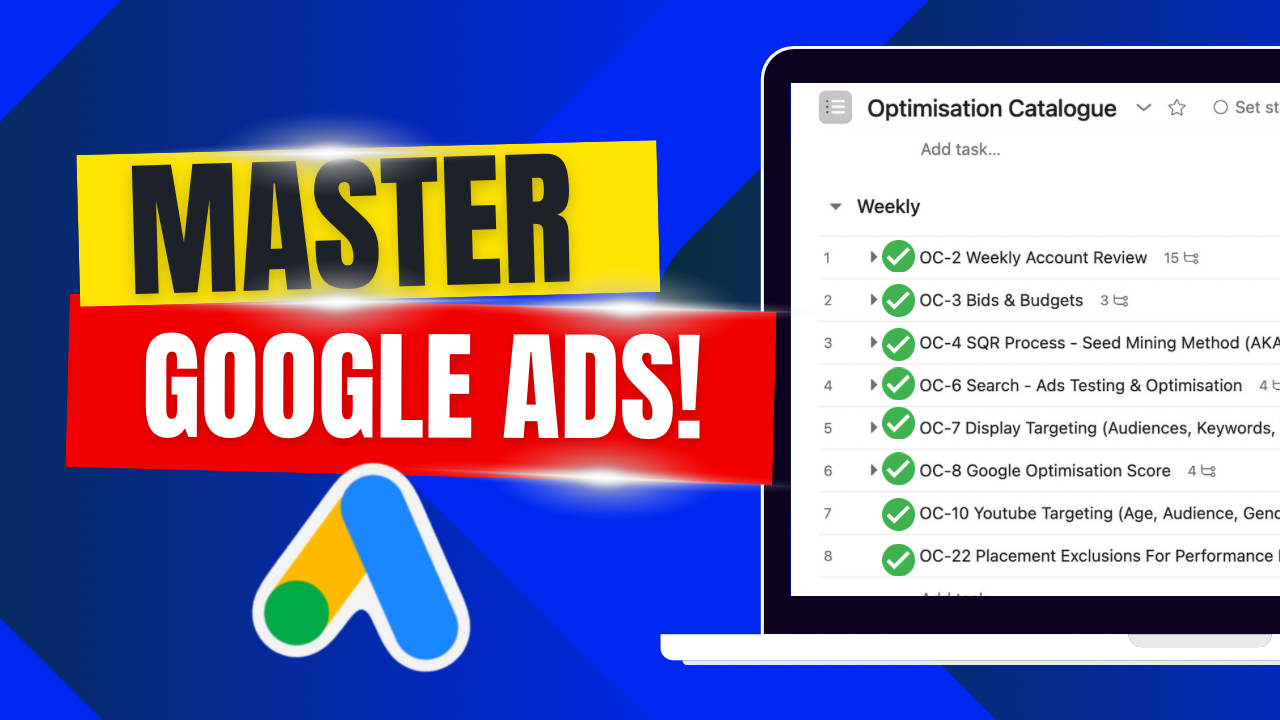Today, I’m sharing something that’s been a cornerstone of our success at Big Flare:
Our Google Ads Optimisation Catalogue.
This isn’t just any checklist, it’s the exact same one we use to keep our clients’ Google Ads accounts performing at their best.
And I’m giving it to you, no strings attached.
If you prefer to watch this blog post as a video, click here.
What’s in the Optimisation Catalogue?
First off, click here to access the catalogue, then read on!
This catalogue is a detailed list of recurring optimisations that we run on our clients’ accounts.
It’s broken down into weekly, monthly, and quarterly tasks to ensure that every aspect of your Google Ads account is regularly reviewed and fine-tuned.
Now this could turn into a lengthy newsletter if I went through every single item in the list in depth. Instead, let’s go through some of the higher priority items, for the rest please dive in to the catalogue itself via the link above.
1. Weekly Account Review
This is def one of the highest priority recurring tasks. The weekly account review is where you get a fresh perspective on your campaigns. It’s not just about going through the motions, it’s about really looking at your account and spotting any new opportunities or issues. Some of the things you want to check each week include:
Impression Shares & Performance: Each week, check your impression shares and how your account is performing compared to the previous week. This helps you understand trends and make informed decisions.
Bids and Budgets: Always start by reviewing your bids and budgets. Prioritise the campaigns, ad groups, and keywords that are spending the most. This ensures that you’re focusing on what’s most impactful.
Product and Ad Approvals: Ensure that your products in Google Merchant Centre and your ads in Google Ads are approved and running. If something is disapproved, it’s crucial to fix it quickly to avoid losing potential revenue.
Week on Week Performance: Check how spend, sales, revenue, ROAS and CPA have changed week over week.
Top Spenders: campaigns, ad groups, ads, keywords, products… all your views in Google Ads should ideally by ordered with top spenders at the top. During the weekly review then it’s a case of scanning through every view to see what the top spending items are doing.
Adalysis Notifications: If you use Adalysis (I do, and I recommend it), review any notifications and performance alerts to stay on top of your account’s health.
2. Bids and Budgets
Bids and budgets are the foundation of any Google Ads account. It’s essential to check them weekly to ensure they align with your performance goals. If a campaign is limited by budget but meeting your ROAS or CPA targets, consider increasing the budget. However, frequent changes aren’t necessary—just make sure everything is on track. If a campaign is not meeting performance targets, dive in to the reasons why before changing anything. Changing too much too often with bids and budgets often harms more than it helps. But digging in to the reasons for performance drops, and often find the other place in the account to work on as a result, is a good place to start.
3. The Seed Mining Method
This is our approach to managing search terms. By reviewing the search query report weekly, we can add high-performing terms as exact match keywords and exclude irrelevant ones. You can use filters here such as “< 50 impressions past 90 days” so that you gravitate more towards the bigger opportunities. Outside of adding new exact match keywords and excluding irrelevant ones, The Seed Minin Method also entails looking at your ad group and keyword structure weekly and looking for opportunities where pulling keywords out into a new grouping could lead to better CTR’s as a result of having more targeted ad copy.
4. Search Ads Testing and Optimisation
Every week, review the performance of your search ads. Pause underperforming ads and headlines, and introduce new ones to test. This continuous testing helps to keep your ads fresh and effective.
5. Shopping Product Feed Optimisation
The frequency here really depends on how big your product feed is and how many times you have already optimised it. For big feeds that are still quite new, you might want to run this process weekly. For smaller feeds or feeds where you have already done a lot of good work on optimisation, you might only need to do this monthly.
The general idea is to be working on improving your product feed at a recurring regular interval. You need to prioritise the work: start with titles. Then move to images. Product Type is often a good third thing on the list to work on. From there you have product description and also a thing we call “product feed richness”, which is a short hand way of saying that you need to make sure all the optional and additional fields in your feed are fully customised and filled out. By default a lot of these will actually be blank.
Keeping Your Account Performing At Its Best
The Big Flare Google Ads Optimisation Catalogue is your practical tool for keeping your Google Ads account well-maintained. By following these recurring tasks—weekly, monthly, and quarterly—you can ensure that your campaigns are always performing at their best. Regular reviews of bids, budgets, and search terms, along with consistent ad testing, help you stay ahead of any issues and will maximise your ad spend. I’ve covered a few of the higher priority items from the list here on this post, but check out the link at the top for the full list of tasks!


